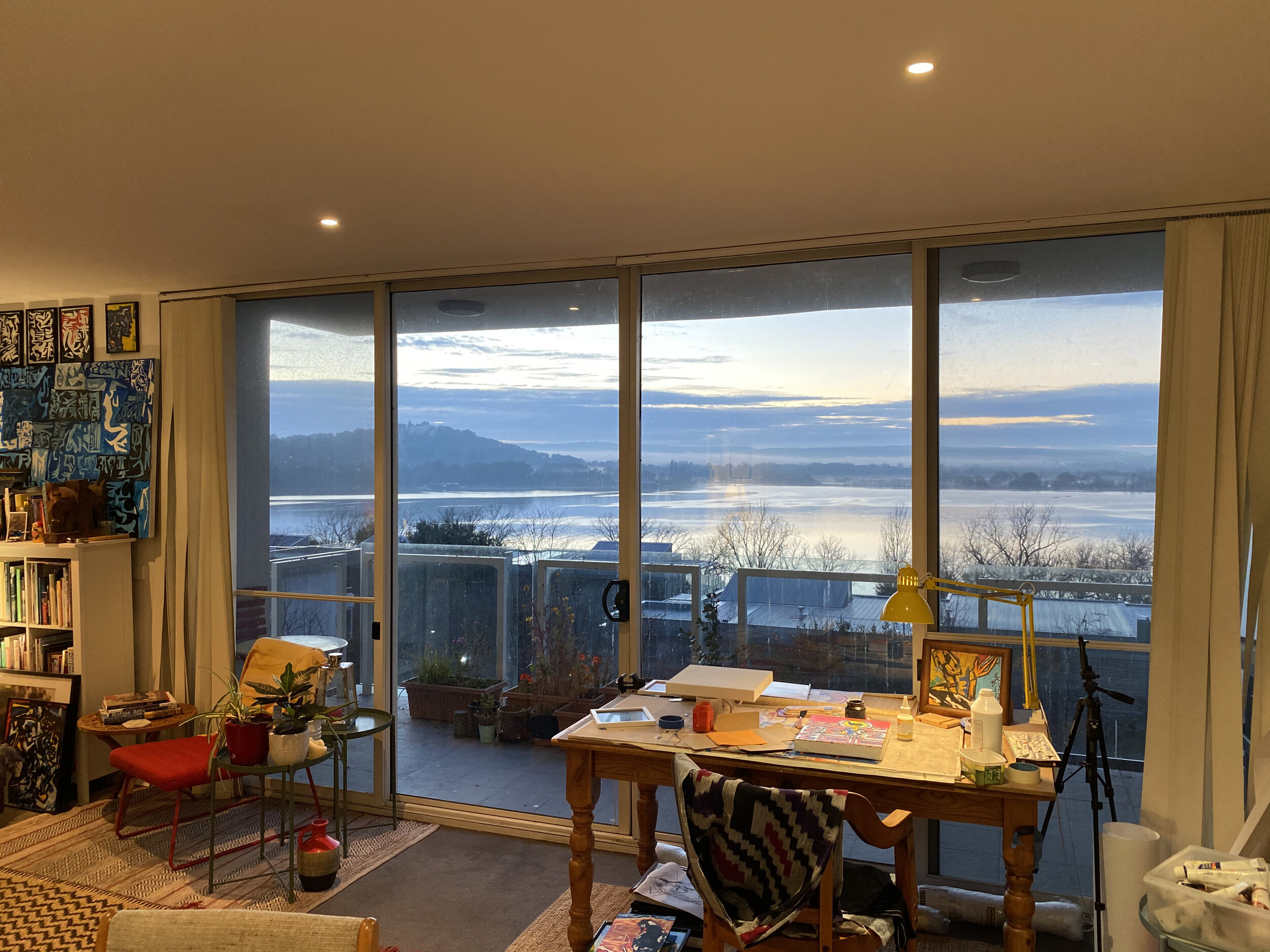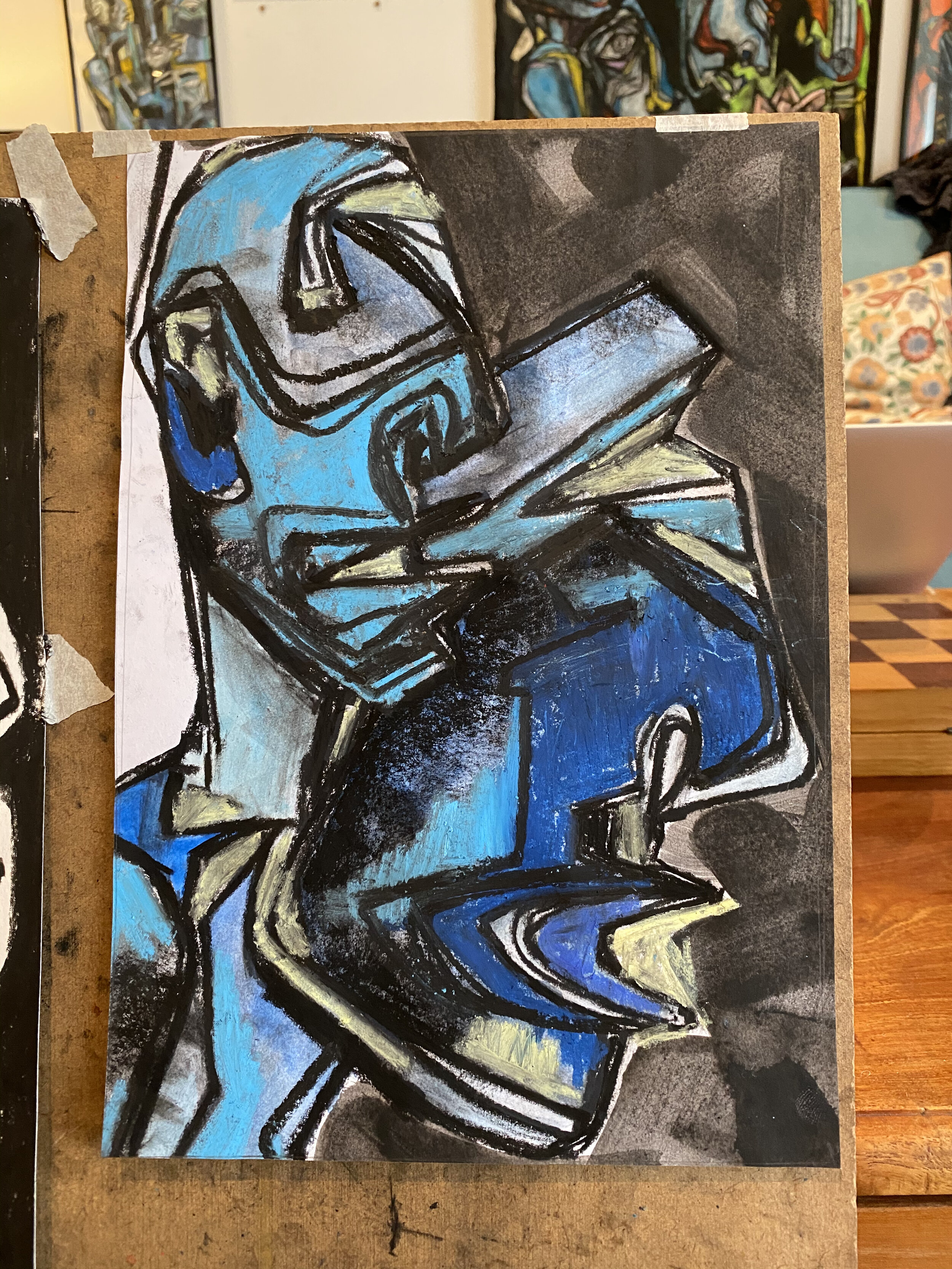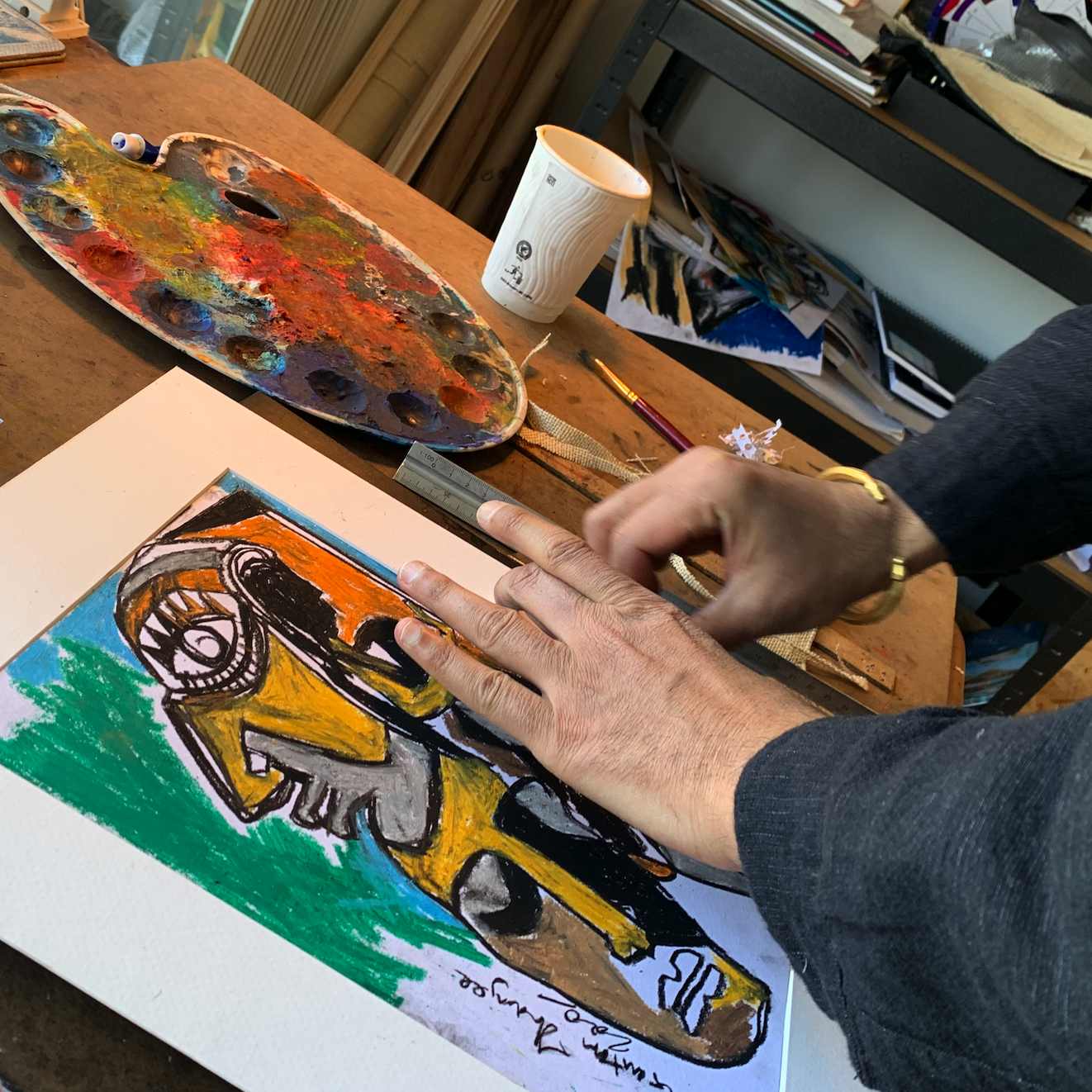Welcome to my Website.
I am an artist focused on archetypal and mythic themes that explore the psychological and spiritual dimensions of the human experience. My work invites institutions and individuals to engage with universal, timeless narratives, encouraging reflection and contemplation. Each piece is grounded in one or more aspects of the sacred and transformative, speaking to an exploration of the great mysteries of life. My mainstay artworks are large, statement paintings on canvas that bring a sense of presence to various settings, fostering a connection with the inner world and its symbols. Created for both personal and public contexts, my works are intended as enduring reflections of meaning and renewal, offering a bridge between the intimate and the universal.
I paint in my flat overlooking stunning Lake Burley Griffin and the beautiful landscape beyond.
My Inspiration and Influences
Dante’s Divina Commedia
I have found Dante’s Commedia fascinating as a perfect allegory of the classic spiritual journey and integration of various aspects of the psyche. Rich with archetypes, the Commedia is an essential cornerstone of Western Civilisation coming out of the medieval period. It begins with these words,
“At the midpoint of the path through life, I found
Myself lost in a wood so dark, the way
Ahead was blotted out.”
From my Clive James’s Translation, Picador Poetry, 2013
I especially love the final line of Canto 33 of Inferno, just before the start of Pergatoria:
“And then we saw the stars again”.
I made a painting of this moment in inks and acrylics on Italian paper in 2021. Click here to view the artwork.
Astrology
‘The stars contain the corpses of the Gods’. The life of celestial and astral realms has been profoundly significant to every culture since the beginning of time, and is intimately connected to all living things - be it the life cycles of an individual human or the birth, ascendancy, maturity, decline and death of a Civilisation, spanning centuries. It’s is my firm belief that the recent 70-100 years or so, which have seen a relative demise in the perceived importance of astrology to human life, is an anomaly that will be corrected as we integrate the scientific paradigm into the greater flow of human development.
In addition to painting, I enjoy making and reading astrological charts for people using primarily Vedic (Indian), Sidereal methods and also Western, Tropical approaches. Each chart has a life and character of its own that contains a wealth of insight and pragmatic wisdom. I also have a keen interest in mundane astrology.
“"The signs of the zodiac are an image of the collective unconscious, each sign corresponding to a specific archetype that influences human behaviour and experiences." - Carl Jung
You can read my newsletter article on a dream-inspired painting that incorporates Astrological concepts on the development of epochs and human consciousness here.
Click here to see my work The Water Bearer, the symbol of the sign Aquarius.
Carl Gustav Jung
It is difficult to overstate the impact of Jung’s expansive oeuvre on me personally and as an artist. His explorations and mapping of the human psyche, its archetypal foundations, structures, dynamics and unfolding over aeons, synthesise millennia of ancient wisdom into a format that is uniquely comprehensible to the modern, post-enlightenment mind.
There is much I consider invaluable in his collected works, but I’ll list just a few of his ideas that have fundamentally altered my worldview. These are the discovery of the Collective Unconscious, his study of dreams, the psychological importance of mythology, fairytales, folktales, the psychology of religion, alchemy, the archetypes as primordial images, the psychology of personality, gnosticism, the anatomy of the psyche and synchronicity.
Joachim of Flora
The 12th Century monk and mystic has been of interest since I first read Carl Jung’s Aion: Researches into the Phenomenology of the Self. Joachim saw the sweep of time as a historical progression of three ages: The Age of the Father, The Age of the Son and Age of the Holy Spirit, which we are on the cusp of beginning. He also wrote of the occurrence of Saturn-Jupiter conjunctions and how they marked marking major historical points of inflection (Jung saw these as ‘synchronous’ events).
I find the subject of Eschatology, especially in Christianity, fascinating.
Indian Civilisation
I was born in India in 1980 and the mark of that land has been carried throughout my life - I have lived in many places and am of mixed European and Indian heritage, but the unique Indian civilisational imprint is fundamental to myself and my artwork.
"India is a place where philosophy is not just thought, but lived. The highest truths are sought not merely through intellectual exercise but through a profound personal experience, a direct encounter with the divine reality." Aldous Huxley
Da Vinci’s Last Supper
I find Da Vinci’s last Supper remarkable on several levels. The Renaissance yearning for the classical world and antiquity is coupled with the then recently invented device of linear perspective - a harbinger of the enlightenment in Western Civilisation and the modern world to come. The painting for me is emblematic of an inflection point in history. There’s also the range of human emotion with every face and gesture, and the glowing serenity of Christ at the centre anchoring the composition. The artistry and technique speak for themselves.
Pierre Teilhard de Chardin
Chardin’s The Phenomenon of Man made a huge impression on me when I first read it. He was a French Jesuit Mystic and Palaeontologist who saw mankind evolving towards an ‘Omega Point’, a spiritual goal. His ideas encompassed science and religion and for me is one of the most interesting voices in the area of Eschatology. This quote from him is one of my favourite:
"Someday, after mastering the winds, the waves, the tides, and gravity, we shall harness for God the energies of love, and then, for the second time in the history of the world, man will have discovered fire."
Rabindranath Tagore
Poet, polymath, artist, Asia’s first Nobel Laureate. Here’s a quote I love from Tagore’s, The Religion of the Forrest:
“WE STAND BEFORE this great world. The truth of our life depends upon our attitude of mind towards it - an attitude which is formed by our habit of dealing with it according to the special circumstance of our surroundings and our temperaments. It guides our attempts to establish relations with the universe either by conquest or by union, either through the cultivation of power or through that of sympathy. And thus, in our realisation of the truth of existence, we put our emphasis either upon the principle of dualism or upon the principle of unity.”
Caravaggio
The master of darkness and illumination through his ‘Chiaroscuro’ approach to indirect painting. Incredible luminosity and lightless voids which stretch into the infinite.
The Crusader Bible
I’ve been interested in medieval illuminated manuscripts for some time but there’s something about the colour scheme and composition of each page in this that I am especially drawn to.
"A masterpiece that transcends time, merging sacred scripture with the cultural and military ethos of the medieval world. Its illustrations not only tell biblical stories but also reflect the chivalric ideals and turbulent history of the Crusades." - Raymond C. E. Cleveland
Iconography
I find Christian iconography powerful and potent for the sacred symbolism and because in essence these icons serve as windows to the divine.
Epochs and the Long Cycles of History
Ecclesiastes 1:4-7:
"A generation goes and a generation comes, but the earth remains forever. The sun rises and the sun goes down; it hurries back to the place where it rises. Blowing toward the south, turning toward the north, the wind returns; it shifts about continually and returns again to its circuits. All rivers run to the sea, but the sea is not full; to the place where they run, the rivers keep running."























